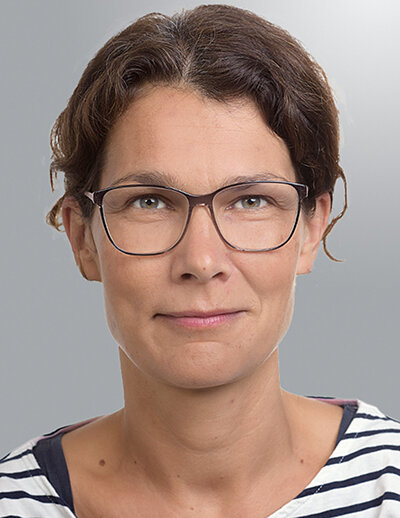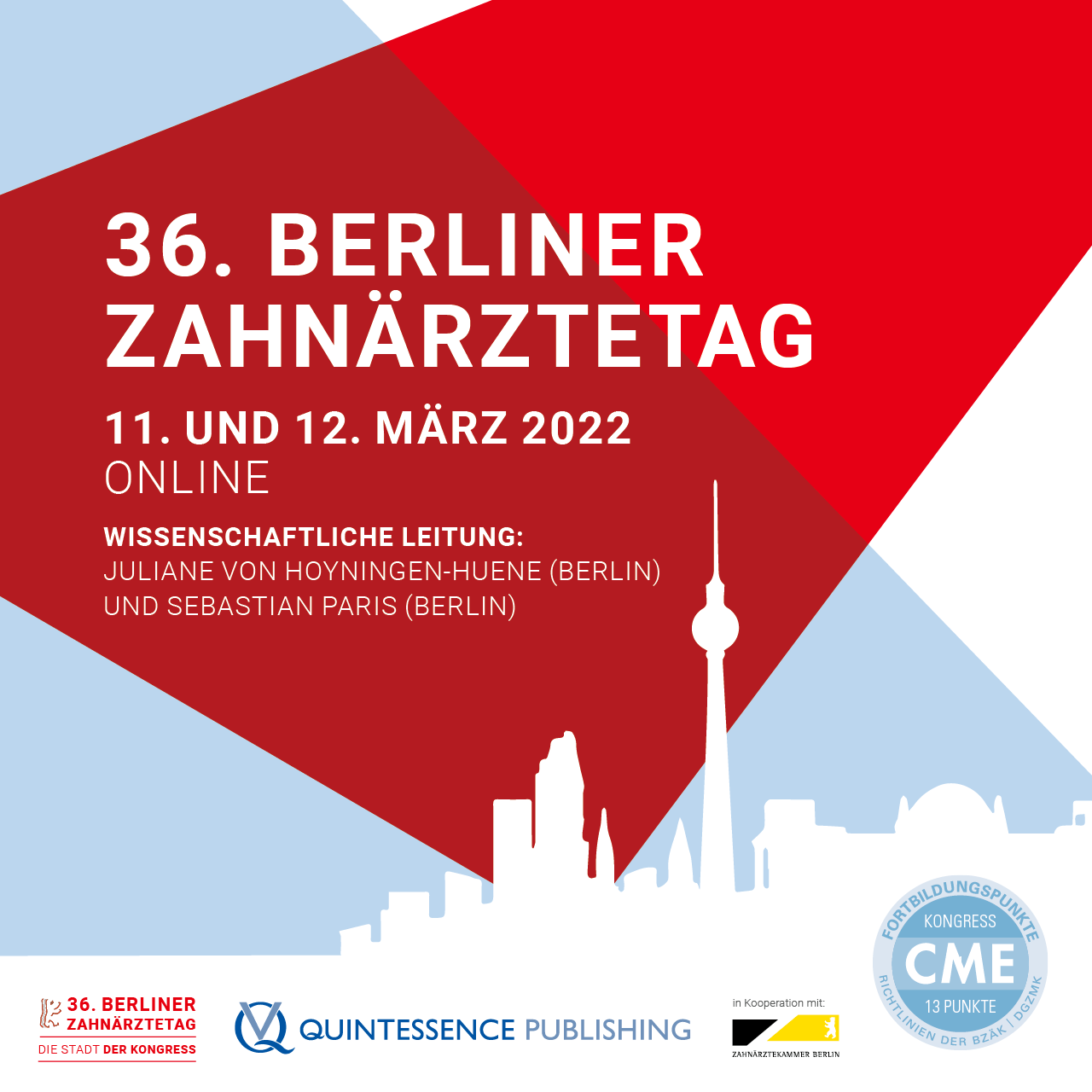Deutsche Zahnärztliche Zeitschrift, 6/2024
BuchbesprechungSeiten: 350-351, Sprache: DeutschBitter, Kerstinvon David Sonntag und Michael Hülsmann (Hrsg.)International Poster Journal of Dentistry and Oral Medicine, 4/2024
Poster 2665, Sprache: EnglischPütz, Natalie / Nguyen, Anh D. / Michaelis, Mary / Bitter, Kerstin / Gernhardt, Christian R.Objectives: This prospective randomized single-blinded clinical study conducted in a split-mouth design examined the impact of an additional application of a flowable composite as a cavity liner in Class I and II composite restorations over 48 months. Methods: According to the study protocol approved by the ethics committee, 100 restorations (Class I and II) were placed in 50 subjects exhibiting two cavities with restorative needs. One cavity was filled solely with a nano-hybrid composite (control group) and the second cavity in combination with an additional layer of a flowable composite (test group). A universal adhesive system was used in both groups in self-etch mode according to the manufacturer's instructions. Clinical evaluation was performed at baseline, 6, 12, 24, 36 and 48 months based on the modified USPHS/Ryge criteria. Results: With a recall rate of 86%, 43 of the initial 50 enrolled patients were evaluated after 48 months. The cumulative survival rate for all restorations was 91.9%. A total of seven restorations (8.1%) were considered failures, three were due to the loss of vitality by endodontic treatment and four due to filling fractures. Five of seven failures were located in the test group (11.6%) and two restorations in the control group (4.7%). In both groups, this corresponds to significantly different cumulative success rates (control group: 95.3%; test group: 88.4 %) and annual failure rates (AFR) (control group: 1.2 %; test group: 2.9 %), respectively (p < 0.05; Mann-Whitney U test). Additionally, compared to the 24 and 36 month results, non-significant differences in parameters such as marginal discoloration and adaption were noted after 48 months. Conclusions: The additional application of a flowable composite did not tend to be superior in this trial and should be further evaluated over a longer period of time. This study was supported by Voco GmbH, Cuxhaven, Germany. Support Funding Agency/Grant Number: VOCO GmbH, Cuxhaven, Germany. No. 31308004KZEP.
Schlagwörter: composite restorations, flowable composite, clinical trial, posterior teeth, adhesive dentistry
International Poster Journal of Dentistry and Oral Medicine, 4/2024
Poster 2666, Sprache: EnglischNguyen, Anh D. / Broscheit, Sina / Vordermark, Dirk / Gerlach, Reinhard / Bitter, Kerstin / Gernhardt, Christian R.Objectives: The objective of this study was to evaluate the microtensile bond strength (µTBS) of three universal adhesives applied in etch-and-rinse and self-etch mode on irradiated and sound human dentin. Methods: 180 extracted third molars were specially prepared allowing dentin perfusion and randomly assigned to two superordinate groups. Ninety teeth received either no irradiation or the high-level therapeutic dose of 60 Gy applied fractionally (2 Gy/day, 5 days/week, 6 weeks). Specimens from each group were randomly divided into six subgroups assigned to three established universal adhesives in either etch-and-rinse or self-etch mode (n=15): Futurabond® U (Fer0, Fer60, Fse0, Fse60), AdheSE® Universal (Aer0, Aer60, Ase0, Ase60), Xeno® Select (Xer0, Xer60, Xse0, Xse60). Bond strength was measured using an universal testing machine immediately after application and light curing of the adhesive materials. Results: The effect of dentin irradiation and application mode for the adhesive restoration was significant (p<0.01, ANOVA). In all groups, a decrease of µTBS was observed when used on irradiated dentin. No significant influence of high level radiation on the bond strength in both modes of Futurabond® U and AdheSE® Universal could be evaluated (p>0.05, Tukey’s test). Only Xeno® Select showed significantly reduced bond strength in self-etch mode after irradiation (Xse60) compared to non-irradiated specimens (Xse0) (p<0.05, Tukey’s test). Evaluated µTBS of all groups (mean values, standard deviations in MPa): Fer0: 23.64 (6.76); Fer60: 17.88 (7.54); Fse0: 23.87 (7.49); Fse60: 19.21 (7.34); Aer0: 29.97 (7.18); Aer60: 29.24 (7.28); Ase0: 35.10 (8.41); Ase60: 26.30 (10.07); Xer0: 26.06 (8.20); Xer60: 22.74 (6.22); Xse0: 24.17 (8.36); Xse60: 11.42 (3.86). Conclusions: Within the limitations of an in vitro study, some effects of high-level tumour irradiation on the bond strength of universal adhesives could be detected. These effects were strongly associated to the used material and application mode.
Schlagwörter: bond strength, universal adhesives, irradiation, adhesive dentistry, tumour-therapeutic radiotherapy
International Poster Journal of Dentistry and Oral Medicine, 4/2024
Poster 2663, Sprache: EnglischGernhardt, Christian R. / Diederich, Antje / Bitter, KerstinObjectives: The purpose of the prospective randomized clinical study in a split-mouth design was to compare the clinical performance of a universal adhesive system (Futurabond U, Voco, Germany) used in both application modes in combination with a nano-hybrid Ormocer© (Admira Fusion, Voco, Germany) after 6 months. Methods: In 50 patients, 19 Class I and 81 Class II cavities were placed with at least two restorations per patient. The adhesive system Futurabond U was used for all the restorations. In one of the two fillings Futurabond U was used as a self-etch adhesive (test group), in the other after conditioning with phosphoric acid (control group). All fillings were placed under rubber dam following the prospective clinical study protocol. The restorations were evaluated at baseline, two weeks following placement, and after six month according to the modified FDI criteria for clinical trials. All data were statistically analysed with the Mann-Whitney U test. Results: After 6 months, 46 patients with 92 restorations were re-examined (92% recall rate). The cumulative survival rate for all restorations was 100%. All teeth remained vital and did not show any signs of postoperative sensitivity. Slight fractures (code Bravo) could be evaluated in three fillings (2 control, 1 test group). None of the teeth showed signs of secondary caries. Statistical analysis showed no significant difference between techniques for any of the evaluation criteria (p>0.05, Mann-Whitney U test). In both groups, this corresponds to cumulative success rates (control group: 100%; test group: 100%) and annual failure rates (AFR) of 0%. Conclusions: After 6 months, the Ormocer© and the different application modes of the universal adhesive used showed no significant impact on the clinical performance of class-I and -II restorations. Furthermore, the universal adhesive Futurabond U might be a promising alternative to other systems. This study was supported by Voco GmbH, Cuxhaven, Germany. Support Funding Agency/Grant Number: Voco, Cuxhaven, Germany. No. 31255331KZEP.
Schlagwörter: clinical trial, composite restoration, adhesive dentistry, posterior teeth
International Poster Journal of Dentistry and Oral Medicine, 4/2024
Poster 2664, Sprache: EnglischWitting, Carl / Michaelis, Mary / Schmidlin, Patrick / Attin, Thomas / Bitter, Kerstin / Heumann, Christian / Gernhardt, Christian R.Objectives: The aim of this placebo-controlled, double-blinded, randomized clinical investigation was to evaluate the influence of 8% arginine-containing prophylaxis products on pain related parameters (Schiff and VAS scores) compared to a negative control in patients from a German dental clinic suffering from severe dentine hypersensitivity (DH) over 24 weeks. Methods: After ethical approval by the Ethics Committee of the Martin Luther University Halle-Wittenberg (Germany), 101 informed patients having at least two teeth (no molars) with air blast DH scores 2, 3 (Schiff Cold Air Sensitivity Scale) were randomly assigned to either the control or test group. All were treated with a single application of the in-office paste followed by daily toothpaste use (control products without desensitizing ingredients and test products containing 8% arginine, both with the same level of fluoride).The Schiff and VAS scores were evaluated before and after application of the in-office paste and after 4, 8, and 24 weeks for both study teeth. Results: A total of 98 patients completed the study. The distribution of subjects with DH Schiff scores 2 and 3 at screening was similar in both groups. There were no statistically significant differences in the Schiff and VAS scores at baseline between test and control subjects (p>0.05). The pooled data for tooth 1 and tooth 2 yielded significantly greater pain relief as assessed by the Schiff score in the test group than the control group at any appointment, both in the t-test and Wilcoxon signed rank test analyses (p<0.05). The VAS showed no significant differences between both groups. Conclusions: Significant improvements (Schiff score, pain relief) in a German population were demonstrated after application of the in-office paste and over the 24- week period of brushing with the 8.0% arginine-containing toothpaste. This study was supported by Colgate-Palmolive Europe, Therwil, Switzerland. Support Funding Agency/Grant Number: Colgate-Palmolive Europe, Therwil, Switzerland. No. GASAS-1105X, PO No. 7501857177.
Schlagwörter: dentin hypersensitivity, arginine, clinical study, oral hygiene, pain relief
Endodontie, 4/2023
Seiten: 423-427, Sprache: DeutschBitter, KerstinEin FallberichtIm vorliegenden Fall werden die Diagnose und Behandlung eines ersten Unterkiefermolars vorgestellt, der einen vom Pulpakammerboden ausgehenden und bis zum approximalen Kavitätenrand verlaufenden Riss aufwies.
Schlagwörter: Cracked tooth, postendodontische Versorgung
Quintessence International, 6/2022
DOI: 10.3290/j.qi.b2644901, PubMed-ID: 35119237Seiten: 522-531, Sprache: EnglischBruhnke, Maria / Bitter, Kerstin / Beuer, Florian / Böse, Mats Wernfried Heinrich / Neumeyer, Stefan / Naumann, MichaelMaintaining and restoring teeth exhibiting subgingival or even subcrestal defect extensions represent a common problem in daily practice. Such teeth are often deemed “unrestorable” due to a significant hard tissue loss and defect locations violating the biologic width. In order to achieve a sufficient 2-mm-ferrule design and reestablish the biologic width, both surgical crown lengthening and orthodontic extrusion have been suggested. However, surgical crown lengthening has a negative effect on the attachment level of adjacent teeth as well as esthetic disadvantages particularly in the esthetic zone. Therefore, orthodontic extrusion might be considered as a valid therapeutic alternative since gingival architecture is maintained. While most orthodontic appliances are too complex for daily application, forced orthodontic extrusion by means of the Tissue Master Concept might be a cost- and time-effective approach due to advances in adhesive and computer-assisted dentistry. This clinical case series illustrates the methodology of the rather straightforward Tissue Master Concept in specific clinical situations that may occur in clinical routine.
Schlagwörter: forced eruption, orthodontic extrusion, tooth extrusion
Quintessenz Zahnmedizin, 5/2021
EndodontieSeiten: 534-542, Sprache: DeutschBitter, Kerstin / Sterzenbach, Guido / Sturm, Richard / Bruhnke, MariaDie unmittelbare bakteriendichte koronale Versiegelung des Wurzelkanalsystems sowie die Herstellung der Kaufunktion sind nach einer adäquaten endodontischen Behandlung grundlegende Faktoren für den langfristigen Erhalt dieser Zähne. Bei der Auswahl der Restauration wird dem Faktor Substanzverlust neben den Parametern Zahntyp, Attachmentverlust und Kronen-Wurzel-Verhältnis sowie prothetische Gesamtbehandlungsplanung eine wesentliche Bedeutung beigemessen. Zusammengenommen bestimmen diese Faktoren die Entscheidung über direkte oder indirekte Restaurationen sowie über die Notwendigkeit der Verwendung eines Wurzelkanalstiftes. Die postendodontische Restauration sollte als integraler Bestandteil der endodontischen Behandlung angesehen werden und dementsprechend zeitnah erfolgen – idealerweise innerhalb von vier Monaten nach der Wurzelkanalfüllung.
Schlagwörter: Postendodontische Versorgung, wurzelkanalbehandelte Zähne, Wurzelkanalstifte, adhäsive Befestigung, forcierte Extrusion
Endodontie, 3/2020
Seiten: 259-271, Sprache: DeutschBitter, Kerstin / Hülsmann, MichaelLiteraturübersichtIn dieser Literaturübersicht soll die Fragestellung beantwortet werden, wie die Effektivität der schallaktivierten Wurzelkanalspülung im Vergleich zur Ultraschallaktivierung und zur konventionellen Handspülung zu bewerten ist. Analysiert wurden die hochfrequente Variante EDDY und eine Variante mit einer weitaus niedrigeren Frequenz, der EndoActivator. Als Parameter wurden die Reinigungswirkung (Entfernung von Debris, Smear Layer, organischem Gewebe, Kalziumhydroxid und Guttapercharesten), die antimikrobielle Effektivität, die Extrusion von Spülflüssigkeit und das Auftreten postoperativer Beschwerden nach Einsatz der Aktivierung herangezogen.
Schlagwörter: Wurzelkanaldesinfektion, EDDY, EndoActivator, Schall, Ultraschall
International Journal of Computerized Dentistry, 1/2020
ApplicationPubMed-ID: 32207463Seiten: 73-82, Sprache: Deutsch, EnglischBurkhardt, Felix / Strietzel, Frank Peter / Bitter, Kerstin / Spies, Benedikt ChristopherHintergrund: Für den Behandlungserfolg einer implantatprothetischen Versorgung ist die Positionierung der Implantate im Knochen von hoher Bedeutung. Insbesondere bei einteiligen Implantaten ist eine nachträgliche Korrektur der Implantatachse nur erschwert möglich. Eine prothetisch orientierte, digitale Planung in Kombination mit einer vollgeführten Implantation kann in diesem Fall ein erhöhtes Maß an Sicherheit bieten.
Fallpräsentation: Zur Rehabilitation einer weitspannigen Schaltlücke in Regio 13 bis 16 wurden drei einteilige Implantate aus Zirkonoxid zur Aufnahme einer Zirkonoxidbrücke mit Extensionsbrückenglied geplant. Für eine optimale Positionierung basierte die Planung auf einem digitalen Set-up und dreidimensionalen DICOM-Daten (Digital Imaging and Communications in Medicine). Die geführte Implantatinsertion wurde mithilfe von Aufsätzen am chirurgischen Winkelstück sowie einer dazu kompatiblen, hülsenlosen Bohrschablone durchgeführt. Für die definitive Versorgung erfolgte die Abformung der Implantate mittels Intraoralscanner. Hierbei auftretende reflexionsbedingte Ungenauigkeiten wurden durch eine digitale Abutmentgeometrie ausgeglichen. Auf Basis dieser überlagerten STL-Daten wurde eine monolithische Zirkonoxid-Restauration subtraktiv gefertigt und adhäsiv zementiert.
Schlussfolgerung: Aufgrund einer vorausschauenden, prothetisch orientierten Planung konnten die einteiligen Keramikimplantate auch ohne Guide-Lösung des Implantatherstellers inseriert werden. Dies war mithilfe von Aufsätzen am chirurgischen Winkelstück und einer dazu kompatiblen Bohrschablone möglich. Dies ist besonders bei einteiligen Implantaten empfehlenswert, da eine nachträgliche Korrektur der Implantatachse nur durch irreversibles Beschleifen der Abutments möglich ist. Durch die Überlagerung der Scandaten mit der importierten, idealen Abutementgeometrie konnte die Genauigkeit der Implantatabformung verbessert werden. Es konnte gezeigt werden, dass mithilfe dieser Methode zukünftig auf eine Gingivaretraktion bei der Abformung dieses Implantattyps verzichtet werden kann.
Schlagwörter: Keramikimplantate, geführte Implantation, backward planning, Intraoralscan, CAD/CAM, digitaler Workflow






